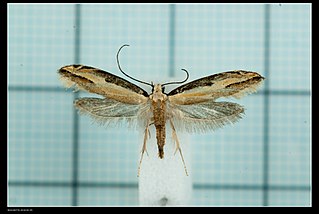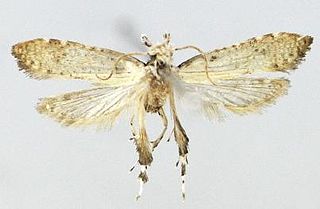Related Research Articles
Ephysteris is a genus of the twirler moth family (Gelechiidae). Among these, it is assigned to tribe Gnorimoschemini of the subfamily Gelechiinae. Even though it is a rather diverse and widespread group, most of these small and inconspicuous moths were overlooked by scientists until the early 20th century. Almost 90 species are known today but new ones are still being discovered.
Pityocona is a small and little-known genus of the twirler moth family (Gelechiidae). Among these, it is believed to belong to subfamily Gelechiinae, but beyond that its relationships are still obscure.
Comodica is a small genus of the fungus moth family, Tineidae. Therein, it belongs to the subfamily Erechthiinae. It is apparently a close relative of the type genus of its subfamily, Erechthias.

Erechthias is a genus of the fungus moth family, Tineidae. Therein, it belongs to the subfamily Erechthiinae, of which it is the type genus. The exact circumscription of this genus is still disputed, but it may encompass more than 150 species.

Trachycentra is a small genus of the fungus moth family, Tineidae. Therein, it belongs to the subfamily Hapsiferinae.

Opogona is a genus of the fungus moth family, Tineidae. Therein, it belongs to the subfamily Hieroxestinae. As it includes Opogona omoscopa, the type species of the now-abolished genus Hieroxestis, it is the type genus of its subfamily.
Wegneria is a genus of moths belonging to the family Tineidae.
Rhodobates is a genus of moths belonging to the family Tineidae. The genus was first described by Ragonot in 1895.
Scalmatica is a genus of moths belonging to the family Tineidae.

Tineovertex is a genus of moths belonging to the family Tineidae.

Proterodesma is a genus of moths belonging to the family Tineidae. All the species in this genus are endemic to New Zealand.
Wyoma is a small genus of the fungus moth family, Tineidae. Therein, it belongs to the subfamily Tineinae. It is probably fairly closely related to the type genus of its family and subfamily, Tinea, and can be most easily separated by the wing venation – in Tinea, two veins in each wing arise from a common stalk, whereas none do in Wyoma.

Endophthora is a genus of moths belonging to the family Tineidae. This genus is endemic to New Zealand.

Eugennaea is a genus of moths belonging to the family Tineidae. It was described in 1914 by Edward Meyrick. The genus contains only one species, Eugennaea laquearia, which is endemic to New Zealand. Meyrick described the species from specimens collected by George Vernon Hudson on Nikau stems at Kaeo in January.
Prothinodes is a genus of moths belonging to the family Tineidae.

Erechthias simulans is a species of fungus moth. It is here considered to belong to the somewhat controversial type genus of its subfamily Erechthiinae, though even fairly recently some authors have proposed to retain other genera such as Decadarchis separate from Erechthias. Decadarchis, with E. simulans as type species, would in fact contain this moth and its closest relatives, regardless whether it is recognized as full genus or as subgenus. These relatives are generally held to be a group of mainly Polynesian species. E. simulans has also been mistaken for a species of the closely related genus Comodica; while the delimitation of this versus Erechthias/Decadarchis is not universally agreed upon, E. simulans is not included in Comodica anymore by modern authors.

Autosticha is a genus of gelechioid moths. It belongs to the subfamily Autostichinae, which is either placed in the concealer moth family (Oecophoridae), or in an expanded Autostichidae. It is the type genus of its subfamily. Originally, this genus was named Automola, but this name properly refers to a fly genus in family Richardiidae.
Dryadaula are a genus of moths belonging to the family Tineidae. It was described by Edward Meyrick in 1893, and it belongs to the subfamily or family Dryadaulidae, according to most recent taxonomies.

Tinissa is a genus of the fungus moth family (Tineidae). Therein, it belongs to the subfamily Scardiinae.

Erechthias darwini is a moth of the family Tineidae. It is endemic to St. Paul’s Rocks, a group of 15 small islets and rocks in the central equatorial Atlantic Ocean. It was first recorded by Charles Darwin.
References
![]() Data related to Catalectis at Wikispecies
Data related to Catalectis at Wikispecies
- Clarke, John Frederick Gates (1986): Pyralidae and Microlepidoptera of the Marquesas Archipelago. Smithsonian Contributions to Zoology416: 1-485. PDF fulltext Archived 2012-03-27 at the Wayback Machine (214 MB!)
- Robinson, Gaden S. [2011]: Global Taxonomic Database of Tineidae (Lepidoptera). Retrieved 2011-DEC-22.